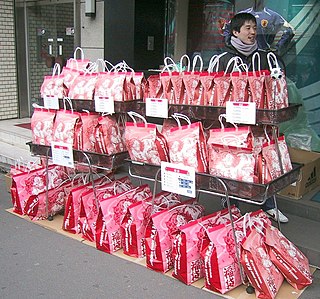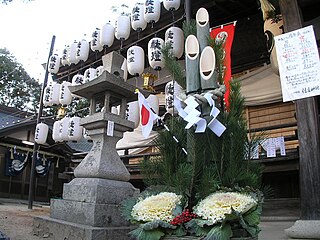 W
WThe Japanese New Year is an annual festival with its own customs. Since 1873, the official Japanese New Year has been celebrated according to the Gregorian calendar, on January 1 of each year, New Year's Day . However, some traditional events of the Japanese New Year are partially celebrated on the first day of the year on the modern Tenpō calendar, the last official lunisolar calendar which was used until 1872 in Japan.
 W
WThe First sunrise refers to the custom of observing the first sunrise of the year. Such a custom may be just an observation of the sunrise on a special day, just for fun, or has a religious meaning for those who worship the sun, such as the Shintoist followers in Japan, for praying for good luck.
 W
WFukubukuro is a Japanese New Year custom in which merchants make grab bags filled with unknown random contents and sell them for a substantial discount, usually 50% or more off the list price of the items contained within. The low prices are usually done to attract customers to shop at that store during the new year. The term is formed from Japanese fuku and fukuro. The change of fukuro to bukuro is the phenomenon known as rendaku. The fuku comes from the Japanese saying that "there is fortune in leftovers" (残り物には福がある). Popular stores' fukubukuro usually are snapped up quickly by eager customers, with some stores having long lines snake around city blocks hours before the store opens on New Year's Day.
 W
WFukuwarai (福笑い) is a Japanese children's game popular at the Lunar New Year. Players are led to a table which has a paper drawing of a human face with no features depicted, and cutouts of several facial features. While blindfolded, the players attempt to place the features onto the face in the correct positions.
 W
WHatsumōde is the first Buddhist temple or Shinto shrine visit of the Japanese New Year. Many visit on the first, second, or third day of the year as most are off work on those days. Generally, wishes for the new year are made, new omamori are bought, and the old ones are returned to the shrine so they can be burned. There are often long lines at major shrines throughout Japan.
 W
WIn Japanese culture, Hatsuyume (初夢) is the first dream one has in the new year. Traditionally, the contents of such a dream would foretell the luck of the dreamer in the ensuing year. In Japan, the night of December 31 was often passed without sleeping, thus the hatsuyume is often experienced during the night of January 1. This is why the day after the night of the "first dream" is known as Hatsuyume. This day is January 2 in the gregorian calendar, but was different in the traditional Japanese calendar.
 W
WJinjitsu is one of the five seasonal festivals that were integrated into the Japanese Imperial calendar over 1,000 years ago. Sekku is the term given meaning special day of observance. The festival is now celebrated on the seventh day of the first month and is considered a part of the New Year observances that are celebrated during this time.
 W
WA kadomatsu is a traditional Japanese decoration as yorishiro of the New Year placed in pairs in front of homes to welcome ancestral spirits or kami of the harvest.
 W
WKagami mochi , is a traditional Japanese New Year decoration. It usually consists of two round mochi, the smaller placed atop the larger, and a daidai with an attached leaf on top. In addition, it may have a sheet of konbu and a skewer of dried persimmons under the mochi. It sits on a stand called a sanpō (三宝) over a sheet called a shihōbeni (四方紅), which is supposed to ward off fires from the house for the following years. Sheets of paper called gohei (御幣) folded into lightning shapes similar to those seen on sumo wrestler's belts are also attached.
 W
WKakizome is a Japanese term for the first calligraphy written at the beginning of a year, traditionally on January 2. Other terms include kissho (吉書), shihitsu (試筆) and hatsusuzuri (初硯).
 W
WThe Festival of Seven Herbs or Nanakusa no sekku is the long-standing Japanese custom of eating seven-herb rice porridge on January 7 (Jinjitsu); one of the Gosekku.
 W
WOsechi-ryōri are traditional Japanese New Year foods. The tradition started in the Heian period (794–1185). Osechi are easily recognizable by their special boxes called jūbako (重箱), which resemble bentō boxes. Like bentō boxes, jūbako are often kept stacked before and after use.
 W
WThe Utakai Hajime is an annual gathering, convened by the Emperor of Japan, in which participants read traditional Japanese poetry on a common theme before a wider audience. It is held on 1 January at the Tokyo Imperial Palace, and is broadcast live on the national television network, NHK.